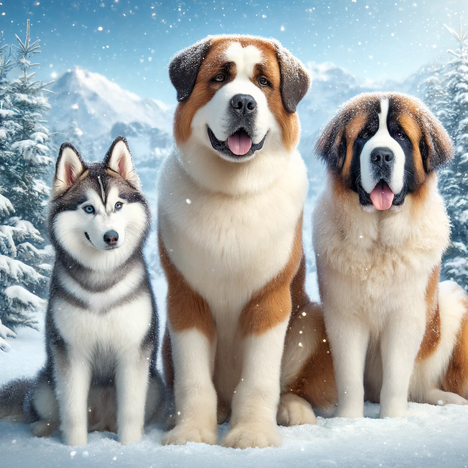Attribute "Cold resistant"

Frosty friends
Dogs are known to be our best friends, and for many of us they are more than just pets - they are family members. However, especially in the colder months of the year, an important question arises: is my dog cold-resistant? In this article, you will find out what exactly "cold-resistant" means for dog breeds, which dog breeds cope particularly well with low temperatures and how you can ensure that your furry companion stays happy and healthy even in cold weather.
What does "cold-resistant" mean for dog breeds?
"Cold hardy" describes a dog's ability to tolerate low temperatures well while remaining healthy and active. This characteristic depends on various factors, including the dog's coat, body size, build and breed origin. Dogs that are considered cold-resistant usually have a dense, insulating coat that protects them from the cold and often have a thicker layer of fat under their skin.
Coat structure and density
One of the most important characteristics of cold-resistant dogs is their coat. These dogs often have a double coat, consisting of a soft, dense undercoat and a protective outer coat. The undercoat acts as an insulating layer and keeps the body heat close to the dog's body, while the outer coat keeps out moisture and snow.
Body size and build
Larger dogs generally have a better volume to surface area ratio, which means they lose less body heat per kilogram of body weight than smaller dogs. In addition, cold-resistant breeds often have a stronger build and a thicker layer of fat, which also helps to retain heat.
Origin of the breed
Most cold-resistant dog breeds originate from regions with cold climates. These dogs have adapted to extreme weather conditions over time. Examples of such breeds are the Siberian Husky, the Alaskan Malamute and the Saint Bernard.
Known cold-resistant dog breeds
Siberian Husky
The Siberian Husky is perhaps the best-known cold-resistant dog breed. Originally bred by the Chukchi people in Siberia, these dogs were used for sled dog sports and as working dogs in icy conditions. Their thick coat and enduring nature make them ideal for cold weather.
Alaskan Malamute
The Alaskan Malamute is another hardy sled dog breed. These dogs have a thick, woolly coat and are known for their strength and endurance. They were bred by the indigenous people of Alaska and are perfectly adapted to the harsh, cold climate.
St. Bernard
The St. Bernard is not only known for its role as a rescue dog in the Swiss Alps, but also for its impressive resistance to the cold. Its thick coat and strong build allow it to work and live in extremely low temperatures.
How to support your cold-resistant dog in winter
Nutrition and care
A balanced diet is particularly important in winter to ensure that your dog has enough energy to maintain its body temperature. High-quality dog food that is rich in proteins and fats can help to provide the necessary energy. Additionally, it is important to brush your dog's coat regularly to prevent tangles from forming and to maintain its insulating properties.
Protection from extreme conditions
Even if your dog is cold-resistant, it should not be exposed to extreme weather conditions for too long. Make sure your dog has access to a warm and dry shelter when outside. In very cold weather, dog boots and coats can provide extra protection, especially for sensitive paws and areas without much fur.
Activity and exercise
Exercise is essential to regulate your dog's body temperature and keep them fit. Schedule regular walks and activities, but be sure to limit outdoor time in extremely cold weather. Indoor play and exercise can be a good alternative when it's too cold outside.




